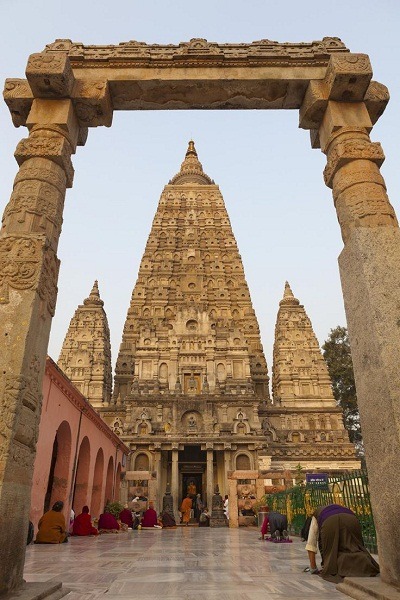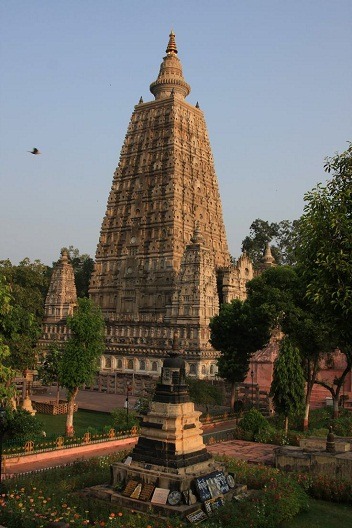Visiting the Mahabodhi Temple: A Journey of Enlightenment in Bodh Gaya

| Category | Details |
| Location | Bodh Gaya, Bihar, India |
| Nearest Airport | Gaya Airport (17 km away) |
| Nearest Train Station | Gaya Junction (12 km away) |
| Best Time to Visit | October to March |
| Great Buddha Statue | 25-meter-high statue of Buddha |
Mahabodhi Temple Bodhgaya India
One of the foremost critical and well regarded Buddhist sanctuaries within the world is the Mahabodhi Temple, which is recognized as a UNESCO World Legacy Location. It assigns the spot under the Bodhi tree where Siddhartha Gautama, long run Buddha, obtained edification. Travelers and pioneers from all over the world are drawn to the sanctuary since it could be a representation of otherworldly edification, tranquility, and reflection.
Mahabodhi Temple Buddha Statue
For Buddhists all around the world, the Mahabodhi Temple at Bodh Gaya, India, is a deeply significant site and a UNESCO World Heritage Site. The calm statue of the Buddha sitting in meditation, representing the moment of his enlightenment beneath the Bodhi tree, sits at the center of it all. This holy location draws both pilgrims and visitors because it provides a serene setting for introspection and spiritual development. For anyone interested in learning more about the origins of Buddhism, a visit to the spiritual and historically rich temple complex is a must. The Mahabodhi Temple offers a singular chance to engage with historical customs and feel the deep tranquility that comes from the Buddha’s enlightenment.
10 Lines on Mahabodhi Temple
- UNESCO World Heritage Site: One of the most well-known UNESCO World Heritage Sites is the Mahabodhi Temple in Bodh Gaya.
- Buddhist Pilgrimage: Buddhists from all over the world travel to this hallowed temple as part of their pilgrimage.
- Historical Significance: It designates the site of the Buddha’s enlightenment, Siddhartha Gautama.
- Ancient History: In the third century BCE, Emperor Ashoka constructed the temple’s original foundation.
- Architectural marvel: The complex of temples includes a calm Bodhi tree, a big diamond throne, and an elaborately built main temple.
- Cultural Hub: The Mahabodhi Temple is a popular destination for people of all faiths, providing a serene setting ideal for introspection and meditation.
- Religious Ceremonies: Especially on Buddha Purnima, it holds a number of religious festivals and ceremonies.
- Visitor services: The location offers lodging and meditation centers, among other services, for both pilgrims and visitors.
- Spiritual Legacy: The Mahabodhi Temple represents the road to enlightenment and the eternal legacy of the Buddha’s teachings.
- Accessibility: Situated in Bihar, India, it receives millions of visitors each year and is conveniently reachable by plane, train, and car.
Where is the Mahabodhi Temple Situated?
The Mahabodhi Temple is arranged within the Indian state of Bihar’s little town of Bodh Gaya. One of the four vital journey locales related with the life of Gautama Buddha is Bodh Gaya, which is found on the banks of the Niranjana stream. Arranged at accurately 24.6969° N scope and 84.9918° E longitude, it is effortlessly reachable from major cities such as Patna and Gaya.
What is the Historical Significance of the Mahabodhi Temple?
The Buddha’s illumination, one of the foremost noteworthy minutes in Buddhist history, is closely connected to the Mahabodhi Temple, giving it gigantic authentic noteworthiness. After a long time of extreme austerities, Sovereign Siddhartha Gautama chosen to think at Bodh Gaya circa 500 BCE. Here, underneath a peepal tree, he come to nirvana, or illumination, which changed him into the Buddha, the “Stirred One.”
Since the third century BCE, amid the rule of Head Ashoka, the Mahabodhi Temple complex has been a popular destination for travelers. The primary sanctuary and the jewel position of royalty (Vajrasana) that stamp the area of edification are ascribed to Ashoka. The sanctuary has seen various repairs and rebuilding efforts over the ages, all of which have contributed to its broad verifiable and social legacy.
When was the Mahabodhi Temple Built?

Sovereign Ashoka built the Mahabodhi Temple ‘s starting building within the third century BCE. The show sanctuary building, which reflects Gupta architectural style, was built within the fifth or 6th century CE. Since at that point, the temple has experienced a few reclamation periods, most strikingly within the Pala Tradition (8th to 12th century) and afterward within the 19th century amid British colonial organization. The Burmese and British governments driven the biggest rebuilding endeavors within the late 19th and early 20th centuries.
What is the Architectural Style of the Mahabodhi Temple?
The Mahabodhi Temple’s engineering plan could be a solitary combination of Gupta-era antiquated Indian engineering with motivations from other times. The pyramid-shaped tower of the 55-meter-tall sanctuary rises above the sanctum sanctorum. The plan includes a sense of otherworldly glory and calm that’s embodied in its towering structure, fragile carvings, and agile extents.
Four littler towers that reflect the most tower’s plan around the essential tower of the sanctuary. The whole building is made of brick, a well known fabric in conventional Indian development, and is brightened with delineations of the Buddha’s life carved out of stucco. Various stupas and sanctums are moreover portion of the sanctuary complex, and they all include to the by and large heavenly climate of the area.
What are the Key Features of the Mahabodhi Temple Complex?
The Mahabodhi Temple complex could be a sprawling location with a few key highlights that highlight its otherworldly and structural importance:
- The Bodhi Tree: The foremost sacrosanct portion of the complex is the Bodhi Tree, a coordinate relative of the first tree beneath which Buddha achieved edification. Pioneers think and offer prayers here, considering it the heart of the sanctuary complex.
- Vajrasana (Jewel Position of royalty): Usually the spot where Buddha sat in reflection. The Vajrasana, a large stone stage, was introduced by Head Ashoka to check this sacrosanct site.
- Fundamental Sanctuary: The central sanctuary could be a towering structure with a sanctum housing a overlaid statue of Buddha within the earth-touching pose (Bhumiśparśa Mudrā), symbolizing the minute of edification.
- Sacrosanct Ponds: There are a few sacrosanct lakes inside the complex, the foremost outstanding being the Lotus Lake where it’s accepted Buddha went through a week in reflection after edification.
- Old Railings: Encompassing the most sanctuary are antiquated sandstone railings dating back to 150 BCE. These railings are embellished with carvings delineating different occasions from Buddha’s life.
- Contemplation Gardens: The beautifully landscaped gardens give a quiet environment for contemplation and reflection, upgrading the otherworldly encounter of guests.
Are There Any Special Events or Festivals Celebrated at the Mahabodhi Temple?
The Mahabodhi Asylum isn’t because it were a area of each day venerate and consideration but besides the center of different celebrations and events all through the year:
- Buddha Jayanti (Vesak): Celebrated in April or May, this celebration marks the birth, brightening, and passing of Buddha. The asylum is delightfully brightened, and exceptional supplications, considerations, and social programs are organized.
- Bodhi Day: Observed on December 8th, Bodhi Day commemorates the day Buddha finished light. Partners take portion in chanting, reflection, and distinctive ceremonies.
- Magha Puja: This vital festival falls on the overall moon day of the Magha month (January/February). It celebrates the gathering of Buddha with his 1,250 lit up aficionados.
- Kathina Ceremony: Held in the midst of the month taking after the conclusion of the stormy season pull back (as a run the show October), ministers are promoted unused robes and other necessities by the lay community.
- Full Moon Thoughts: On each full moon night, the haven has exceptional consideration sessions, drawing experts from around the world.
The Mahabodhi Temple’s energetic celebration calendar and day by day traditions make it a living, breathing picture of Buddhist certainty and legacy, inviting thousands of visitors who search for otherworldly consolation and illumination.
Conclusion
the Mahabodhi Temple isn’t fair an structural wonder but a significant otherworldly sanctuary that has stood the test of time. Its authentic importance, structural excellence, and sacrosanct vibe proceed to rouse and draw in millions, making it a essential journey location and a reference point of Buddhist culture and history.
For best travel experiences You can visit Cleartrip.com.


Leave a Reply